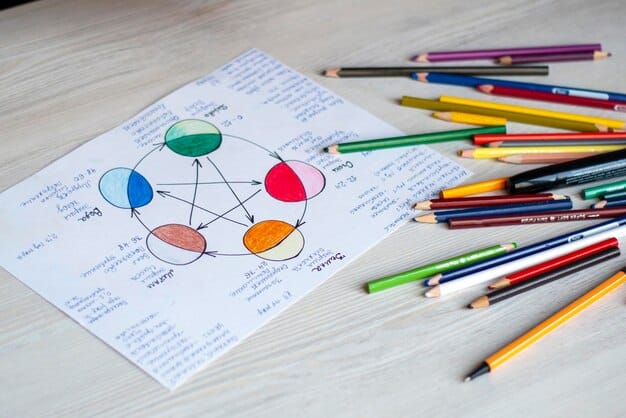Ace Your Exams: Learning Styles and Test-Taking Strategies

Understanding your learning style and adapting test-taking strategies can significantly improve your academic performance by aligning study habits with how you process information most effectively.
Do you struggle with exams despite studying hard? Discover how understanding your learning styles and test-taking strategies: tailoring your approach for optimal performance can transform your academic experience and boost your grades.
Understanding Your Learning Style
Identifying your learning style is the first step toward more effective studying. Understanding how you process information can help you tailor your study habits for optimal retention and recall.
There are several recognized learning styles, each with its own strengths and preferred methods. Let’s explore some of the most common learning styles and how to recognize them.
Visual Learners
Visual learners absorb information best through sight. They benefit from seeing information presented in diagrams, charts, and videos.
Auditory Learners
Auditory learners prefer to learn through listening. Lectures, discussions, and audio recordings are effective for them.
Kinesthetic Learners
Kinesthetic learners learn best through hands-on activities and physical experiences. They benefit from activities like building models or participating in experiments.
- Visual: Thrives on diagrams, charts, and videos.
- Auditory: Excels in lectures, discussions, and listening to recordings.
- Kinesthetic: Learns best through hands-on activities and physical experiences.
- Reading/Writing: Prefers absorbing information through written words.
By understanding your learning style, you can adapt your study techniques to suit your strengths, making learning more efficient and enjoyable. Recognizing how you process information best can lead to significant improvements in your academic performance.
Understanding your learning style is pivotal. It allows you to tailor study techniques, improving your understanding and retention of the material.

Tailoring Study Techniques to Your Learning Style
Once you’ve identified your learning style, the next step is to adapt your study techniques to match. This ensures that you’re engaging with the material in a way that resonates with how you learn best.
Tailoring your study techniques to your learning style is a game-changer. It transforms studying from a chore into an engaging, effective process.
Visual Learners
Visual learners benefit from using visual aids such as mind maps, diagrams, and flashcards. Color-coding notes and watching educational videos can also enhance their learning experience.
Auditory Learners
Auditory learners should focus on lectures, discussions, and audio recordings. They can also benefit from reading aloud and participating in study groups where they can discuss the material.
Kinesthetic Learners
Kinesthetic learners thrive on hands-on activities and movement. They can benefit from activities such as building models, acting out concepts, or using physical objects to aid in learning.
- Mind Maps and Diagrams: Creating visual representations of information.
- Listening to Lectures: Engaging with the material through audio.
- Hands-On Models: Building and interacting with physical objects.
By tailoring your study techniques to your specific learning style, you can enhance your understanding, improve retention, and make studying a more enjoyable and effective experience.
Tailoring your study techniques to your learning style enables you to grasp information more effectively and boost your overall academic performance.
Effective Note-Taking Strategies for Different Learning Styles
Effective note-taking is a crucial skill for academic success. However, the best note-taking methods vary depending on your individual learning style.
Note-taking isn’t just about writing things down; it’s about actively engaging with the material in a way that suits your learning style.
Visual Learners
Visual learners can use mind maps, diagrams, and color-coded notes to organize information visually. They should also use symbols and illustrations to enhance recall.
Auditory Learners
Auditory learners should focus on capturing the main points and key words during lectures. They can also benefit from recording lectures and reviewing them later.
Kinesthetic Learners
Kinesthetic learners should incorporate physical actions into their note-taking process. They can benefit from using interactive notebooks, creating physical models, or standing and moving while taking notes.

- Visual: Mind maps, diagrams, color-coding.
- Auditory: Capture main points, record lectures.
- Kinesthetic: Interactive notebooks, physical models.
By adapting your note-taking strategies to your specific learning style, you can create a study resource that is both effective and engaging, leading to improved retention and academic performance.
Adapting note-taking to your learning style helps you organize and recall information effectively, enhancing your study sessions.
Optimizing Your Study Environment
The environment in which you study can significantly impact your ability to focus and retain information. Optimizing your study environment to suit your learning style can enhance your study sessions.
Creating the right study environment is key to maximizing your focus and learning efficiency. A tailored environment can make all the difference.
Visual Learners
Visual learners should study in a well-lit, visually stimulating environment. They can decorate their study space with posters, diagrams, and colorful materials.
Auditory Learners
Auditory learners should study in a quiet environment with minimal distractions. They can use noise-canceling headphones or study in a library.
Kinesthetic Learners
Kinesthetic learners should study in a flexible environment that allows for movement. They can use a standing desk, take frequent breaks to move around, or study in a location where they can fidget or pace.
Creating a study environment that aligns with your learning style can help you focus, reduce distractions, and improve your overall learning experience and academic outcomes.
Optimizing your study environment based on your learning style reduces distractions and enhances focus, promoting a more effective study session.
Test-Taking Strategies for Different Learning Styles
Effective test-taking strategies are essential for performing well on exams. Tailoring these strategies to your learning style can provide a significant advantage.
Knowing your learning style can influence your test-taking approach, leading to improved performance and reduced test anxiety.
Visual Learners
Visual learners should use visual aids to recall information during the test. They can create mental images or sketches to remember key concepts. Reading questions carefully and looking for visual cues in diagrams or charts are also helpful.
Auditory Learners
Auditory learners should read the questions aloud (if permitted) and try to “hear” the answers in their head. They can also benefit from replaying lectures or discussions in their mind to recall information.
Kinesthetic Learners
Kinesthetic learners should use physical actions or movements to help them recall information. They can tap their fingers, move their legs, or use hand gestures to trigger their memory.
- Visual: Use visual aids, create mental images.
- Auditory: Read questions aloud, replay lectures in mind.
- Kinesthetic: Use physical actions, tap fingers.
By adapting your test-taking strategies to your learning style, you can access and recall information more effectively, leading to improved performance and greater confidence during exams.
Adapting test-taking strategies to your learning style improves information recall and boosts performance on examinations.
Managing Test Anxiety Based on Learning Style
Test anxiety can significantly impact your performance during exams. Understanding your learning style can help you develop strategies to manage this anxiety effectively.
Addressing test anxiety through the lens of your learning style can create a more personalized and effective approach to staying calm and focused.
Visual Learners
Visual learners can use visualization techniques to calm their nerves before and during the test. They can imagine themselves succeeding, visualize the test environment, or use calming mental images.
Auditory Learners
Auditory learners can listen to calming music or use positive affirmations to reduce anxiety. They can also benefit from talking through their concerns with a friend or family member before the test.
Kinesthetic Learners
Kinesthetic learners can use physical exercises or relaxation techniques to relieve anxiety. They can take deep breaths, stretch, or engage in calming activities such as yoga or meditation.
By tailoring your anxiety management techniques to your specific needs, you can reduce stress, improve focus, and perform at your best during exams.
Managing test anxiety using strategies aligned with your learning style enhances focus and reduces stress, helping you perform better.
| Key Concept | Brief Description |
|---|---|
| 💡 Learning Styles | Visual, auditory, kinesthetic, and reading/writing. |
| 📝 Note-Taking | Adapt note-taking to your learning style. |
| 🧘♀️ Test Anxiety | Manage anxiety with relevant techniques. |
| 🎯 Study Environment | Optimize your study space for focus. |
Frequently Asked Questions
▼
The main learning styles are visual, auditory, kinesthetic, and reading/writing. Visual learners learn best through seeing, auditory learners through listening, and kinesthetic learners through hands-on activities.
▼
You can identify your learning style through self-assessment quizzes, reflecting on your preferred study methods, and noticing which types of activities help you retain information most effectively.
▼
Tailoring study techniques to your learning style enhances understanding, improves retention, and makes studying a more enjoyable and effective experience. It aligns with how you naturally process information.
▼
Visual learners can create mental images, use diagrams, and look for visual cues in the questions. Also, carefully reading questions and visualizing answers helps improve performance and recall.
▼
Kinesthetic learners can use physical exercises, relaxation techniques, and deep breathing to manage test anxiety. Stretching and moving can also help release tension and improve focus.
Conclusion
Understanding your learning style and adapting your study and test-taking strategies accordingly can significantly improve your academic performance. Tailoring your approach to match how you learn best enhances understanding, reduces anxiety, and promotes greater confidence in your abilities.





